
Collinsia is a genus of about 20 species of annual flowering plants, consisting of the blue eyed Marys and the Chinese houses. It was traditionally placed in the snapdragon family Scrophulariaceae, but following recent research in molecular genetics, it has now been placed in a much enlarged family Plantaginaceae.
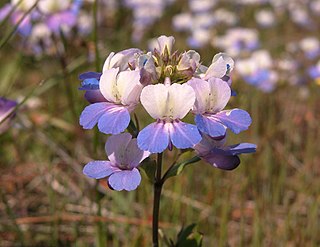
Collinsia grandiflora is a species of flowering plant in the plantain family known by the common names giant blue eyed Mary and large-flowered collinsia. This wildflower is native to western North America from British Columbia to northern California where it grows in coniferous understory and woodland.

Collinsia parviflora is a species of flowering plant in the family Plantaginaceae known by the common names maiden blue eyed Mary and small-flowered collinsia.

Collinsia parryi is a species of flowering plant in the plantain family known by the common name Parry's blue eyed Mary. It is endemic to central and southern California, where it is found in the southern Coast Ranges and in the Transverse Ranges north and east of Los Angeles.

Chenopodium fremontii is a species of flowering plant in the family Amaranthaceae known by the common name Frémont's goosefoot. Both the species' specific epithet, and the common name derive from the 19th century western pioneer John C. Frémont.
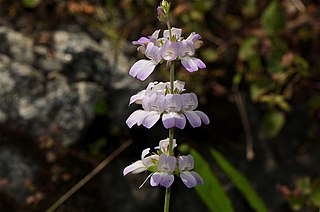
Collinsia bartsiifolia is a species of flowering plant in the plantain family known by the common name white blue-eyed Mary.

Collinsia callosa is a species of flowering plant in the plantain family known by the common name desert mountain blue-eyed Mary. It is endemic to California, where it grows in the mountains of the southernmost Sierra Nevada, the Transverse Ranges, and the mountains of the Mojave Desert region. It grows in desert scrub, chaparral, and woodland habitat on the mountain slopes.

Collinsia concolor is a species of flowering plant in the plantain family known by the common name Chinese houses.
Collinsia corymbosa is a species of flowering plant in the plantain family known by the common name round-headed Chinese houses. It is endemic to the coastline of California north of the San Francisco Bay Area, where it is uncommon and scattered. Its habitat is the sand dunes of the immediate coastline. This is an annual herb producing a scaly, hairy, red to reddish green stem which grows upright or decumbent to a maximum length of about 25 centimeters. The thick, sparsely hairy leaves are rippled and lobed along the edges, which may be somewhat turned under. The inflorescence is a dense whorl of several distinctive flowers. Each has a hairy calyx of lobed reddish sepals and a corolla up to about 2 centimeters long. The flower has two small upper lobes and three longer lower lobes which come together in a nearly tubular shape. It is generally white with a light purple tint. The smaller upper lobes curl back and dry to brown at their lips.
Collinsia greenei is a species of flowering plant in the plantain family known by the common name Greene's blue-eyed Mary.
Collinsia linearis is a species of flowering plant in the plantain family known by the common name narrowleaf blue-eyed Mary.
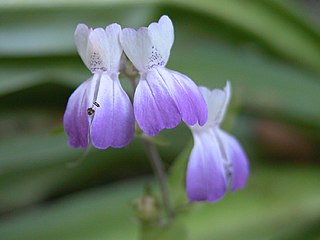
Collinsia multicolor is a species of flowering plant in the plantain family, known by the common names San Francisco blue eyed Mary and San Francisco collinsia. It is endemic to the San Francisco Bay Area, where it is known from San Francisco to Santa Cruz. As of 2008 there are 22 known occurrences. Populations south of Santa Cruz have been extirpated.
Collinsia rattanii is a species of flowering plant in the plantain family known by the common name sticky blue-eyed Mary. It is native to the coniferous forests of the Pacific Northwest of the United States from Washington to northern California. It is an annual herb growing up to 40 centimeters tall with linear leaves rolled under along the edges. The leaves are hairy on the upper surface and hairless and purple-tinted underneath. The inflorescence is coated in sticky glandular hairs. It has a series of nodes from which arise one to five flowers each on pedicels. The flower is only 4 to 8 millimeters long, with two mostly white upper lobes and three mostly purple lower lobes.

Collinsia sparsiflora is a flowering plant in the family Plantaginaceae known by the common names spinster's blue-eyed Mary and few-flowered collinsia. One variety of the species is native to the West Coast of the United States as far north as Washington, while the other three varieties are limited to California alone.
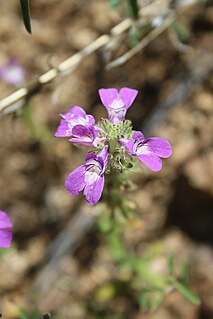
Collinsia tinctoria is a species of flowering plant in the family Plantaginaceae known by the common names sticky Chinese houses and tincture plant.

Collinsia torreyi is a species of flowering plant in the plantain family known by the common name Torrey's blue-eyed Mary. It is native to California and adjacent sections of Oregon and Nevada, where it grows in the coniferous forests of several mountain ranges, including the Sierra Nevada.

Collinsia verna, or blue-eyed Mary, is a winter annual that is native to the eastern and central parts of North America but has become endangered in the states of New York and Tennessee. The flowers are bicolored white and blue. It is a plant of valley bottoms and moist bottom slopes, in areas with moderate lighting and requires some shade.
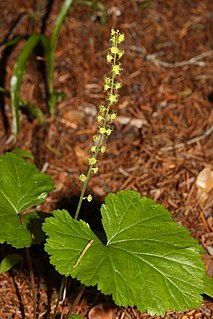
Mitella breweri is a species of flowering plant in the saxifrage family known by the common names Brewer's mitrewort and Brewer's bishop's cap. It is native to western North America from British Columbia to central California and Nevada, where it grows in moist meadows, woods, and mountain forests. It is a rhizomatous perennial herb growing up to about 30 or 40 centimeters tall. Most of the leaves occur around the base of the stem. They have rounded blades several centimeters wide and edges divided into dull toothed lobes. The erect inflorescence bears several flowers, sometimes over 50, usually along one side of the stem. The distinctive flower is saucer-shaped with five greenish petals which are divided into narrow, whiskerlike lobes.

Packera breweri is a species of flowering plant in the aster family known by the common name Brewer's ragwort. It is endemic to central California, where it occurs in the woodlands and grasslands of the Central Coast Ranges. They are more frequently found in mid-southern counties of California near the coast, such as Kern or Monterey.
Triteleia dudleyi is a species of flowering plant known by the common name Dudley's triteleia. It is endemic to California, where it is known from sections of the High Sierra Nevada and the Transverse Ranges. It is a plant of subalpine climates, growing in mountain forests. It is a perennial herb growing from a corm. It produces two or three basal leaves up to 30 centimeters long by one wide. The inflorescence arises on an erect stem up to 30 or 35 centimeters tall and bears an umbel-like cluster of many flowers. Each flower is a funnel-shaped yellow bloom that dries purple. The flower has six lobes measuring up to 1.2 centimeters long. There are six stamens with lavender anthers.















